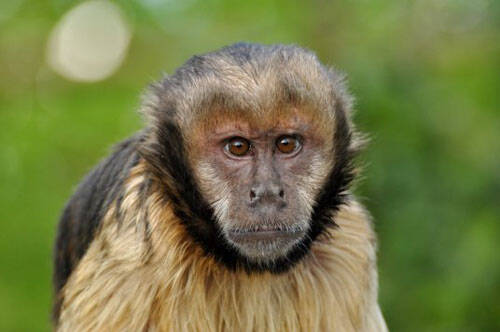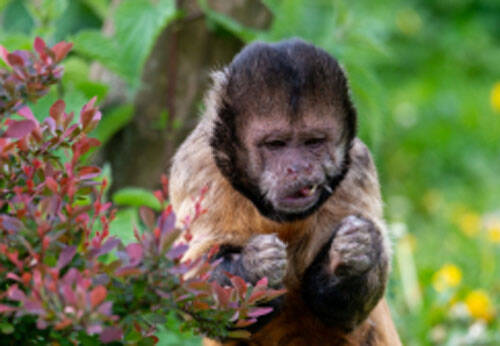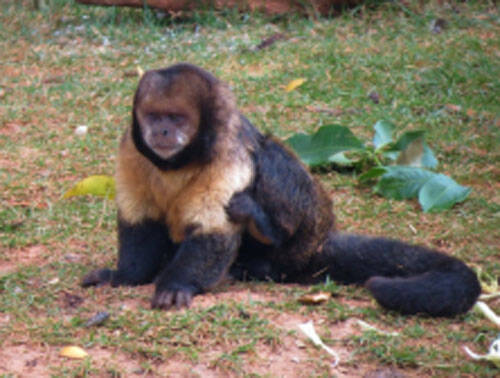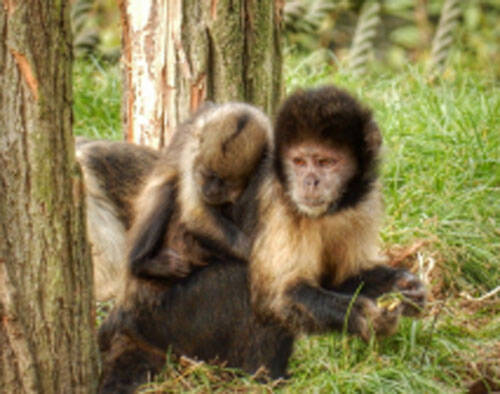Sapajus xanthosternos
IUCN
LCBasic Information
Scientific classification
- name:Sapajus xanthosternos
- Scientific Name:Sapajus xanthosternos, Buff-headed Capuchin、Yellow-breasted Capuchin,Gelbbrust-Kapuzineraffe,Macaco-prego, Macaco-prego-de-peito-amarelo
- Outline:Primates
- Family:C.m.family
Vital signs
- length:35-48.8cm
- Weight:1.3-4.8kg
- lifetime:No verification information
Feature
Yellow to golden on the chest, abdomen, and upper arms
Distribution and Habitat
It is found in Brazil to the west and north of Rio de Janeiro, east of the Atlantic Ocean and south of the Jequitinhonha River; it covers an area of 470,000 km2, including Sergipe, most of Bahia and northeastern Minas Gerais.
The original distribution range includes the Atlantic Forest (humid coastal forest) and the transition zone between the Cerrado/Atlantic Forest (semi-deciduous dry forest), as well as a smaller area of the Caatinga (deciduous dry forest). The species not only uses primary forests, but is also able to move between forests with moderate human disturbance, especially in areas with low hunting pressure.
Appearance
The golden-bellied capuchin is 35-48.8 cm long; weighs 1.3-4.8 kg for males and 1.4-3.4 kg for females; tail length 37.5-49 cm. Males are slightly larger than females. All members of the genus Capuchin have large, forward-facing eyes, rounded heads, and flat snouts. They also have prehensile tails, which are used primarily for grasping branches and holding onto them while moving. The golden-bellied capuchin has fingers with long nails, non-opposable thumbs on the forelimbs, and opposable big toes on the big toes. The species is a capuchin with tufted hair. The "tuft" refers to a tuft of dark hair along the top of the head of adults. Two tufts of hair with a horn-like appearance may form; juveniles lack these. Their bodies are covered with light brown or dark brown fur. The fur along the shoulders and abdomen is golden yellow. The chest is the same golden yellow, or golden red. They are small in size, with light cheek color. The sides of their faces, feet, hands, and the tip o
Details
Sapajus xanthosternos (scientific name: Sapajus xanthosternos) English Buff-headed Capuchin, Yellow-breasted Capuchin, German Gelbbrust-Kapuzineraffe, Portuguese Macaco-prego, Macaco-prego-de-peito-amarelo, no subspecies.

The golden-bellied monkey is arboreal, diurnal, moves on quadrupeds, and tends to spend most of its waking hours foraging for food. They are very good at swinging between trees, running on two legs, and jumping between trees. The species lives in small groups of 8-30 individuals of the same species, with a sex ratio of 1:1. The group has a social hierarchy. Among the males, there is only one alpha male, and all other males in the group rank lower. While the alpha male is not necessarily the strongest or largest of the males, it is the most dominant. Groups often engage in social grooming as a means of creating group cohesion; the dominant male is usually the most well-groomed by the other members of the group. Sometimes, when the activities of different groups overlap, the alpha male will protect his group, its resources, and its territory. There is also a female alpha male who outranks the other females. However, she is not as dominant as the alpha male.
Golden-bellied scimitar monkeys, like other members of the genus Scimitar, also practice urine washing. Urine washing is a territory marking practice in which animals soak their hands with urine and then rub this substance around their bodies. This urine scent travels with them and infuses their living space. In addition to urine, scimitar monkeys rub other odorous objects on their bodies. In general, golden-bellied scimitar monkeys are excellent throwers and are very smart and dexterous. They also use tools and crack nuts.

Golden-bellied monkeys are quite noisy animals. They make short and frequent whining sounds similar to newborn puppies. It Their alarm call is a unique two-tone jingle. Sometimes the vocalization sounds similar to a bird-like rising whistle. The secreted chemical messages are used to indicate territorial boundaries and sexual receptivity. Tactile and visual cues are also important in communication. As hinted by the species' large, forward-facing eyes, they are also visual animals with good depth perception, and have a keen sense of smell that allows them to identify and distinguish scent trails left by members of another group. As dexterous animals, tactile sensitivity is another important way these monkeys perceive their environment.
Golden-bellied Capuchins are omnivores, eating fruits, seeds, nectar, pith, stems, nuts, berries, flowers, leaves, bird eggs, insects, frogs, small reptiles, birds, bats, other small mammals, and in coastal areas, even oysters and crabs. In general, the diet of Golden-bellied Capuchins is more diverse than that of any other New World monkey. They are extractive and manipulative foragers. They are often destructive in their foraging activities, as they tear branches and leaves apart. The sound of nuts hitting branches, as well as the noisy noises of their movement between trees, can be heard from great distances away.

The golden-bellied hanging monkey is a polygamous, multi-male and multi-female mating system. They are cooperative breeders. In terms of mate selection, females prefer to mate with the monkey king because the monkey king can provide the best protection for their cubs. Cooperative breeders. The mating ritual includes a performance in which the female stares at the male and raises her eyebrows. Additionally, the female moves her head back and forth and approaches the male. At some point, she touches, then runs away and begins to coo. While the male may not seem interested at first, after multiple attempts by the female, he may make eye contact and make vocalizations. The male and female then engage in a physical display that includes leaping and spinning in the air. After the flirting is over, copulation occurs, followed by a short period of continued hopping. Studies have shown that competition for females is intense between males. The alpha male tends to have the greatest reproductive success, although lower-ranking males are also able to mate. The alpha female of the group tries to become the exclusive mate of the alpha male, and may use aggression toward other females. The estrous cycle of the golden-bellied monkey may be similar to the 18-day estrous cycle of the female black-capped monkey.
The golden-bellied monkey can mate and give birth at any time of the year. The time between births may be similar to that of the black-capped monkey, at 22 months. The gestation period lasts from 150 to 180 days, with one offspring born per litter. Newborns weigh between 250-290 kg. Weaning usually takes place around 2 months, and the process can last until the offspring are about 11 months old. Independence from the mother occurs around 6-12 months. Females reach sexual maturity around 4-5 years of age, but they may not reproduce until around 7 or 8 years of age. Males reach sexual maturity 6 to 8 years after birth.

Rylands estimated in 1982 that the density in Una, Bahia, Brazil was 0.72 groups per square kilometer, or 10.8 individuals per square kilometer. Kierulff et al. estimated in 2005 that the density in Una, Bahia, was 4.4 individuals per square kilometer. Ferrari et al., 2010, found 0.6 groups per km2 or 4.6 individuals per km2 at the Trapsa farm (Itaporanga d'Ajuda/Sergipe municipality). It can be inferred that over the course of 48 years or three generations, the species has decreased by 80% or more, currently (2019-2034) and in two generations (2035-2066). This is due to forest loss, hunting and the pet trade, as well as potential threats from diseases such as yellow fever.
Listed in the IUCN Red List of Threatened Species (IUCN) 2020 ver3.1 - Critically Endangered (CR).
Listed in Appendix I, Appendix II and Appendix III of the 2019 edition of the Convention on International Trade in Endangered Species of Wild Fauna and Flora (CITES).
Protect wild animals and eliminate game.
Maintaining ecological balance is everyone's responsibility!








